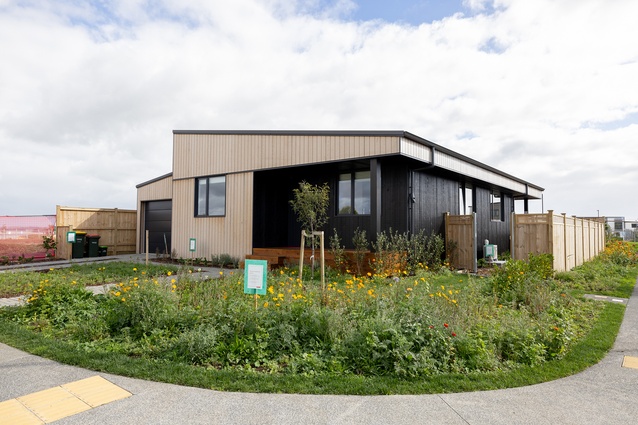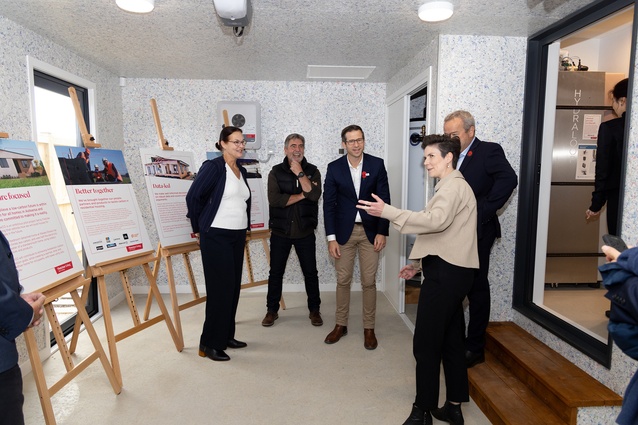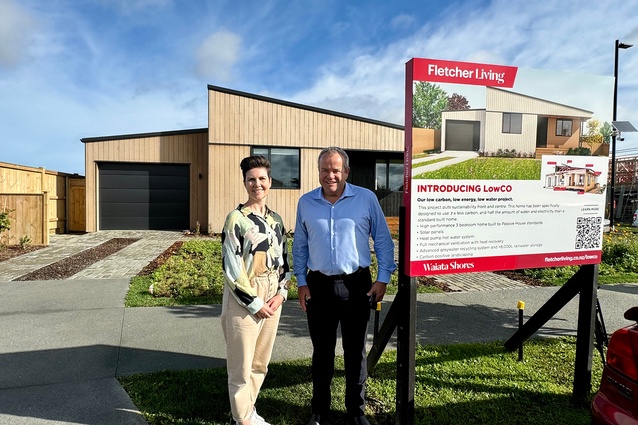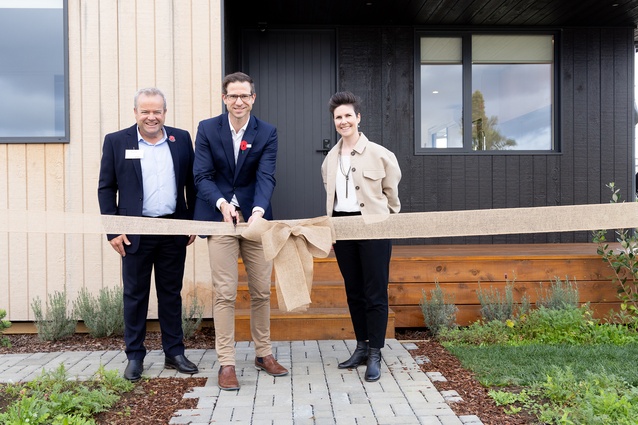Fletcher Building launches low-carbon housing pilot, LowCO
As the country’s second biggest house builder,1 Fletcher Building has taken a significant step towards reducing its carbon footprint with the official launch this month of LowCO, a residential project designed to reimagine the future of home construction in New Zealand.
The concept and developed design stages for the eco-housing project were created by Dave Strachan and Liese Thomson at Strachan Group Architects, with Architype engaged as the detailing architects for the design, led by Tim Ross.
Strachan and Thomson said they were looking to create a “compact, affordable floor plan providing good indoor and outdoor amenity to residents and also focussing on the detailing to increase occupant comfort while creating a low-carbon design.” In terms of the final carbon numbers, the pair explains that product selection was part of initial design considerations.
Ross says Architype drew from its experience with sustainable building to realise SGA’s design into a low-energy and low-carbon detailed design. The resultant LowCO buildings have a Homestar 10 rating, generate seven times less carbon than a standard Kiwi home over its lifetime,2** ensure 90% diversion of waste materials from landfill during construction, provide energy efficiency that maintains a 20–21 degree Celsius indoor temperature all year round, offer potable water savings of 80% (houses)/50% (terraces), and include bio-diversity rich, minimal-care landscaping.
View and download the standalone house and townhouse plans here.
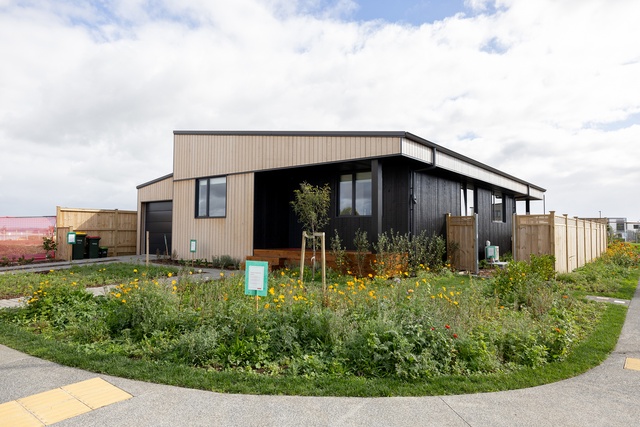
With the construction and energy use of residential projects being one of the largest contributors of carbon emissions, building differently is key to achieving a low-carbon future. Fletcher Building says it aims to drive this transformation by leveraging the materials and building expertise from across different businesses.
“On average, the lifespan of a home is 90 years3,” says Steve Evans, Chief Executive of Fletcher Building’s Residential and Development Division. “We did some research and found that, over that time, homes emit seven times more carbon than is acceptable if we are to keep global warming within the 1.5-degree Celsius limit.’’
“We set about designing and building a number of different house typologies that use seven times less carbon than the average home,” explains Evans. “These homes redefine the standards of modern living by using less carbon along with significantly reducing energy consumption and water usage.”
The recently completed first LowCO build at Fletcher Living’s Waiata Shores development includes a three-bedroom detached home plus a three-unit terrace block. Both builds fit within New Zealand’s 1.5 degree carbon budget for new built homes.

To minimise carbon emissions, considerable planning went into which combination of systems and products will reduce the embodied carbon of a home plus minimise the ongoing operational carbon that day-to-day life emits.
“We often get asked what it costs to build a high-performance home such as LowCO,” says Evans. “While there are slightly higher upfront costs when building, from the point of view of the lifecycle of the home, it will cost less overall due to the reduction in electricity and water consumption.”
“Understandably this is a different way of looking at the financials of home ownership. We would like to engage with banks and others on how long-term building performance could be taken into consideration at the point homeowners are looking for finance.”
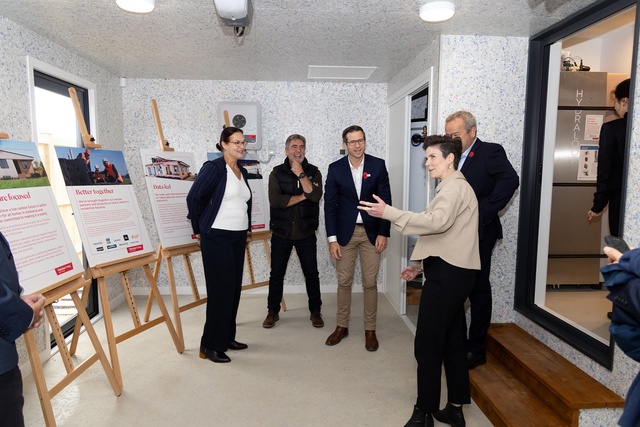
Head of Sustainability for Fletcher Living Nicola Tagiston has led the project from the start and explains the LowCO project goes beyond building four high-performance homes. “It is helping generate momentum around the important conversations we have to have as an industry about the future of housing in Aotearoa.”
A core part of the project is the smart monitoring built in throughout LowCO. This will allow Fletcher Living to capture three years of data on the home’s energy and water use. This data will advance the understanding of the thermal performance of LowCO and provide the intelligence to continue evolving the product. The data will also aid Fletcher Living’s decisions on which components to incorporate into its standard home build.
LowCo’s external partners include:
- Strachan Group Architects for concept design, with Architype for the detailed house design
- Sustainable Engineering to conduct lifecycle analysis and assess thermal performance
- PTL for structural engineering, Revolve Energy for engineered solar and monitoring system design
- Beca for landscape design focusing on carbon reduction, biodiversity and ecological performance
- Watercare to integrate water-saving technologies that recycle water and decrease consumption
Learn more about LowCO here.
References:
1. BCI Central data from the latest NHA report (April 2023 to March 2024) shows Fletcher Residential as the second biggest home builder in New Zealand at 573 builds. This figure is based on the number of times Fletcher Building have appeared in building consent data provided to BCI Central by all TLAs (territorial authorities) over the past 12 months.
2. Ministry of Business, Innovation & Employment. (2020, August). Whole-of-Life Embodied Carbon Emissions Reduction Framework, Building for climate change programme, ISBN 978-1-99-001947-0 (online). Crown copyright. https://www.mbie.govt.nz/dmsdocument/11794-whole-of-life-embodied-carbon-emissions-reduction-framework
3. Chandrakumar, C., Dowell, D., Jaques, R., McLaren, S. J. (2020, February). A science-based approach to setting climate targets for buildings: The case of a New Zealand detached house. Building and Environment, Volume 169, Pgs. 25, 30. 106560, ISSN 0360-1323, https://doi.org/10.1016/j.buildenv.2019.106560. (https://www.sciencedirect.com/science/article/pii/S0360132319307723)*
* Findings from the above article are in alignment with BRANZ technical guidance from the below report:
Bullen, L., Dowdell, D., McLaren, S (2021, March). Carbon Budget of New Zealand Buildings: A Sensitivity Assessment, ER63 External Research Report. BRANZ. https://www.branz.co.nz/pubs/research-reports/er63-carbon-budget-new-zealand-buildings-sensitivity-assessment/
**Based on Fletcher Building’s data the average New Zealand home emits 270t of CO2 equivalent over its average lifetime of 90 years. LowCO is modelled to emit just 37t of CO2. The terrace units will emit just 34t of CO2.


